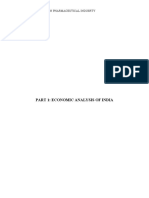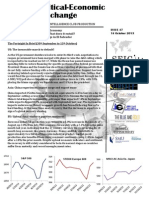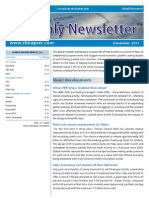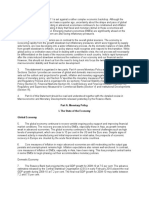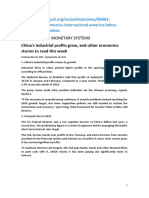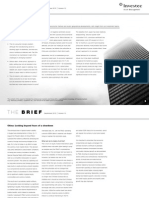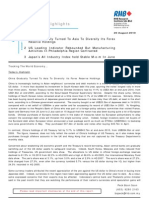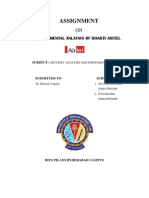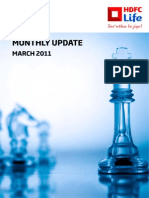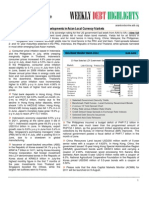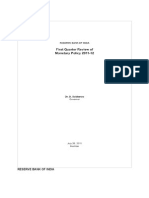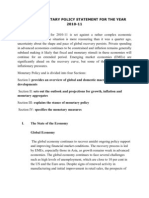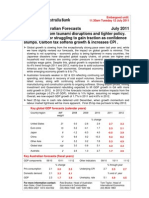Link
Link
Uploaded by
Manali KambleCopyright:
Available Formats
Link
Link
Uploaded by
Manali KambleCopyright
Available Formats
Share this document
Did you find this document useful?
Is this content inappropriate?
Copyright:
Available Formats
Link
Link
Uploaded by
Manali KambleCopyright:
Available Formats
MARCH 2011
MARCH 2011
Predicting earthquakes is very easy; even I can do it! Why; because there are hundreds of them every day. I am always correct when I say there will be an earthquake today.So; the hard part is not the simple prediction of an earthquake; it is stating how strong or big it will be and more importantly the location and timing.We all know that California will fall into the Pacific Ocean, we just dont know when. Two earthquakes that have been predicted for years have hit markets and the responses to them are very different. One sits on a major tectonic fault line. In Japan at least 25,000 people are dead or missing after the biggest quake to hit there in almost 100 years that is predicted to have caused close to US$300 billion of damages and will almost certainly drive the country into a recession. Initially the global equity market sold off but then almost immediately, other than in Japan, shrugged their collective shoulders and moved back to or above where they had started. Why; because the Bank of Japan provided almost infinite liquidity to the markets and because this was a domestic catastrophe that had almost no economic impact on the rest of the world. One sits on a major economic asset. In the Middle East the popular uprising against totalitarian and dictatorial regimes continues apace. It started in Tunisia and moved on to Egypt, we then saw it erupt in Bahrain and Yemen and slide into Syria and international markets, by and large, ignored the issues because it did not impact on their economic interests. Come the day and Libya explodes, the world wakes up and decries a dictator and looks to protect the democratic rights of its people, why, the rest of the worlds economic interests are now at risk. Oil prices are up about 20% since the unrest started and up over 70% from the lows of last year. This damages the economic prospects of all consumers and India is one of the biggest of them. So I correctly predict that there will be more earthquakes in the financial markets, including India over the coming months, European sovereign debt, American banks, higher inflation, social unrest in Asia, but.!
Market Performance and yield level changes
Review of the Economy
A number of recent indicators suggest that economic momentum has slowed. Industrial output growth fell from an average of 13.9% YOY in H1 2010 to 7.6% in H2 2010 and further to 3.7% in January. Real GDP growth also moderated from 8.9% in Q1 2010 to 8.2% in Q4 2010, mainly due to weakness in the manufacturing sector. In its mid-quarter policy review, the Reserve Bank of India (RBI) was more hawkish as it is felt that underlying inflationary pressures have accentuated. They raised key policy rates by 0.25%, making it the eighth increase since the start of 2010. The RBI also revised its inflation forecast sharply upward, it is now expected to reach 8% by this March-endthis is up from the 7% forecast in January and a much lower 5.50% that was their forecast in November last year. The Wholesale Price Index (WPI) was 8.30% versus 8.23% previously, accelerating over Januarys inflation and above analysts expectations. Primary articles inflation moderated as expected, but the rise in non-food manufacturing inflation was higher than expected (Chart 2). Some domestic economic data points improved during the month. The current account deficit expectation was lowered to 2.50% of GDP (Chart 1) as exports grew more than 49% in the month of Feb-11, with overall exports for the 11-month period in FY11 crossing $200 billion (total FY10 figure was $178 billion); the shrinking trade deficit contained the current account deficit to US$ 9.7bn in Q3FY11. Secondly, the central Governments advance tax collection registered a growth of 25%, improving the outlook for corporate performance for the quarter ending Mar-11. Lastly, the Index of Industrial Production (IIP) grew more than expected to 3.70%, reinforcing expectation of the central bank continuing its policy of raising interest rates to fight inflation. On the global front, European industrial production increased in January for the fourth month as companies in Germany (the regions largest economy) boosted output to meet surging export orders. Industrial Production in the Euro-zone rose 6.60% YOY, a tad higher than analyst expectations. Moodys downgraded Spain to Aa2 from Aa1, warning of further cuts to the countrys credit ratings. The US unemployment rate unexpectedly fell to a two-year low of 8.8% in March as employers created more jobs than forecast, adding to evidence that the labour market recovery is gaining traction. The US GDP figure was also revised upward to 3.1%, led by a jump in consumer spending. Chinas central bank ordered its banks to set aside more cash for the third time this year (and the ninth time since 2010), judging that inflation remains a big threat to the worlds second largest economy.
Indices BSE Sensex BSE 100 BSE Mid Cap BSE Small Cap MSCI Europe # MSCI World # MSCI Emerging Market # 3 month Yield * 10 y Gov Yield * 10 y AAA Yield*
MonthEnd Level 19445.2 10095.7 6873.4 8175.9 95.5 1334.9 1170.9 7.31% 7.99% 9.15%
1-Month Change 9.10% 9.03% 7.85% 4.59% -2.45% -2.73% 4.10% +0.17% -0.03% -0.02%
3-Month Change -5.19% -5.43% -11.91% -15.45% 5.99% 4.01% 1.43% +0.13% +0.07% +0.19%
6-Month Change -3.11% -5.00% -14.98% -20.20% 9.58% 12.26% 7.95% +1.16% +0.15% +0.48%
1-Year Change 10.94% 8.55% 0.99% -3.78% 8.61% 10.30% 14.96% +3.04% +0.16% +0.36%
* As yields rise (fall), bond prices fall (rise); the longer the maturity of the bond the larger the change in price for a given change in interest rate. # Changes in the index values are based in INR.
Review of Markets Equity market
March saw India outperforming the global indices for the first time in 2011 as it emerged as the best-performing market, up 9% (although Korea beats India on a dollar-adjusted basis). One of the reasons for the improving trend was that during the month, FIIs bought roughly $1,556 mil as they turned into buyers for the first time in 2011; also, domestic mutual funds remained buyers for the fourth consecutive monthof approximately $86 mil.whereas insurance companies turned sellers of over $100 mil. The BSE Sensex bounced back and touched a two-month high in March after touching an eight-month low in February. The mid-cap and small-cap indices underperformed large caps for the fifth consecutive month. The BSE Midcap and BSE Small Cap indices underperformed the BSE-100 by about 1.25% and 4.5% respectively. Among sectors, the outperforming sectors were domestic rate-sensitive sectors such as auto, banks and real estaterising between 12% and 17%; defensive sectors such as FMCG and healthcare underperformed for the second consecutive monthrising between 4% and 5%. However, Indias ranking is still among the bottom five emerging markets on a year-to-date or 6M basis, and it continues to show an underperformance compared to developed markets (Chart 3).
Chart 1: Balance of Payments
Fixed Interest Market
The returns in the Indian bond markets remained flat with the benchmark 10-year Govt. bond yield moving down 0.03% and ending the month at 7.99% thanks
MARCH 2011
Chart 2: Inflation and Interest Rates
to improved liquidity in the system (overnight borrowings during the month down to approximately Rs. 60,000 crore from close to Rs. 100,000 previously). Government announced its borrowing calendar for FY12 with 60% of the budgeted gross borrowing slated for the first half of FY12, which means that debt issuance between April and September will be around 2.5 trillion rupees billion). were The total their ($56
The long-dated corporate bond market moved in line with the Govt. market with the spread of 10-year AAA bonds staying at 1.16%. Medium-term corporate bonds slightly outperformed both Govt. bonds and long-term corporate bonds. In the shorter end of the market, 1-year CD rates were at 9.80% vs. 10.17% in the previous month.
Outlook for the Economy
The OECDs composite leading index for India has moved below its long-term trend and this suggests that the economy is in a slowdown phase. However, two major tailwinds export revival and an improving fiscal conditionin the economy suggest that this slowdown is transitory and that growth should rebound as policy traction improves. Inflation continues to haunt the economy with recent numbers suggesting an uptick in manufacturing inflation, and food inflation being a structural issue.
Outlook for Markets We are slightly positive on the Equity market
We are positive on the equity market. The Government is expected to table reform bills in the next parliamentary session and state elections are expected to be behind us in a couple of months. Markets will keenly watch the upcoming corporate results and the developing profits expectations for this fiscal, these events are expected to provide triggers to the market. Strong inflows have been witnessed across emerging markets in recent weeks, possibly suggesting reversion of flows into emerging markets, after the tactical shift towards developed markets witnessed in the past few months. The participation breadth of Indian midcaps has also improved of late. The key concern for the Indian equity market going forward remains the rising crude levels, as well as a possibility of reversal of FII flows, particularly the volatile ETF flows.
Chart 3: Performance of Equity Indices
We are neutral on the Fixed Income market
A lower-than-expected first-half borrowing figure of 60% of the fiscal year total is likely to put less upward pressure on bond yields and is expected to leave some scope for private sector borrowings. The liquidity situation is expected to improve further in April as funds mopped up in advance tax collection flow back into the money markets. However, inflation continues to remain at elevated levels and the central bank is expected to respond through 3 more interest rate hikes in the coming months. Against this backdrop, we have revised our portfolio stance to neutral vis-a-vis the benchmarks. We will look to take advantage of market volatility through active duration management.
The past Charts of Equity, Fixed Interest returns and Macro Economic Data Points
Chart 1 shows Balance of Payments and Chart 2 highlights Inflation and Interest Rates. Chart 3 and Chart 4 depict the equity and debt market performance over the past year.
Chart 4: Performance of Debt Indices
MARCH 2011
As on 31-3-2011
Returns in % (Less Than or Equal to 1yr : Absolute Returns, greater than 1 year : CAGR Funds Inception Date Benchmark 1 Yr Fund Equity Equity Pension 16/2/2006 3/5/2008 BSE 100 6.25 7.64 BM 8.55 8.55 3 Yrs Fund 6.15 8.24 BM 7.03 7.03 5 Yrs Fund 9.19 NA BM 11.32 NA Since Inception Fund 11.31 5.83 BM 13.25 4.67
Prime Equity
1/1/2010
8.36
8.55
NA
NA
NA
NA
5.07
7.46
Prime Equity Pension
1/1/2010
8.26
8.55
NA
NA
NA
NA
4.41
7.46
Balanced
11/2/2004
Crisil Bond Fund Index(70%) and BSE 100(30%) Crisil Bond Fund Index(85%) and BSE 100(15%) Crisil Bond Fund Index(50%) and BSE 100(50%) Constant Maturity 5 year Gsec (50%) and BSE 100(50%) NA
5.76
6.11
6.03
6.26
7.30
7.56
9.99
10.11
Secure
11/2/2004
5.45
5.59
7.58
6.10
8.05
6.75
8.73
7.84
Growth Active Asset Allocation Guaranteed Growth Market Shield
11/2/2004
5.65
6.81
6.24
6.48
8.16
8.63
12.13
13.12
18/1/2011
NA
NA
NA
NA
NA
NA
2.03
1.82
30/1/2008
5.55
NA
6.10
NA
NA
NA
5.96
NA
22/12/2010
NA
NA
NA
NA
NA
NA
NA
-2.03
NA
Debt
11/2/2004
Crisil Bond Fund Index.
6.50
5.06
8.93
5.93
7.86
5.94
7.07
5.58
Debt Pension Liquid Pension
3/5/2008 3/5/2008 Crisil Liquid Fund Index.
6.81 6.00
5.06 6.21
9.02 7.13
5.93 6.21
NA NA
NA NA
8.69 7.18
5.75 6.29
Preserver
1/1/2010
Constant Maturity 5 year Gsec
7.66
5.42
NA
NA
NA
NA
11.91
4.82
Preserver Pension
1/1/2010
7.76
5.42
NA
NA
NA
NA
12.35
4.82
MARCH 2011
Fund Profile
The fund seeks to generate income through an investment mix of high quality bonds and money market instruments.
Movement of NAV
Launch Date: Nov.2, 2004 NAV: Rs.15.50 AUM: Rs.755m
Portfolio Chart
Corporate Debt
Return
Period One month Three months Six months One year Since inception Absolute return 1.07% 1.70% 2.68% 6.50% 7.07% Index 0.85% 1.39% 2.40% 5.06% 5.58%
Money market
Gsec
Debt Fund
Returns less than 1 year are absolute, and greater than 1 year are compounded annualised. They are net of charges. Index is the Crisil Bond Fund Index.
Fund Profile
The fund seeks to achieve long term moderate capital growth through an investment mix of upto 20% equity and the balance in high quality bonds and money market instruments.
Movement of NAV
Launch Date: Nov.2, 2004 NAV: Rs.17.11 AUM: Rs. 306m
Portfolio Chart
Corporate Debt
Return
Period One month Three months Six months One year Since inception Absolute return 2.06% 0.18% 1.00% 5.45% 8.73% Index 2.08% 0.37% 1.29% 5.59% 7.84%
Money market Gsec Equity
Returns less than 1 year are absolute, and greater than 1 year are compounded annualised. They are net of charges. Index is a composite of Crisil Bond Fund Index(85%) and BSE 100(15%)
Secure Fund
MARCH 2011
Fund Profile
The fund seeks to achieve long term capital growth through an investment mix of upto 40% equity and the balance in high quality bonds and money market instruments.
Movement of NAV
Launch Date: Nov.2, 2004 NAV: Rs.18.40 AUM: Rs. 1048m
Portfolio Chart
Corporate Debt
Return
Period One month Three months Six months One year Absolute return 3.22% -1.15% -0.51% 5.76% 9.99% Index 3.30% -0.65% 0.18% 6.11% 10.11%
Money market Gsec Equity
Since inception
Balanced Fund
Returns less than 1 year are absolute, and greater than 1 year are compounded annualised. They are net of charges. Index is a composite of Crisil Bond Fund Index(70%) and BSE 100(30%)
Fund Profile
The fund seeks to achieve long term accelerated capital growth through an investment mix of upto 60% equity and the balance in high quality bonds and money market instruments.
Movement of NAV
Launch Date: Nov.2, 2004 NAV: Rs.20.83 AUM: Rs. 15734m
Portfolio Chart
Equity
Return
Period One month Three months Six months One year Absolute return 4.66% -2.75% -2.39% 5.65% 12.13% Index 4.94% -2.02% -1.30% 6.81% 13.12%
Money market
Gsec
Since inception
Corporate Debt
Growth Fund
Returns less than 1 year are absolute, and greater than 1 year are compounded annualised. They are net of charges. Index is a composite of Crisil Bond Fund Index(50%) and BSE 100(50%)
MARCH 2011
The fund seeks to achieve long term moderate capital growth while meeting guarantees provided, through an investment mix of upto 40% equity and the balance in high quality bonds and money market instruments.
Fund Profile
Movement of NAV
Launch Date: Jan. 30, 2008 NAV: Rs.12.00 AUM: Rs. 638m
Portfolio Chart
Corporate Debt
Return
Period One month Three months Six months One year Since inception Absolute return 1.64% -0.14% 0.07% 5.55% 5.96%
Money market
Equity
Guaranteed Growth Fund
Returns less than 1 year are absolute, and greater than 1 year are compounded annualised. They are net of charges.
Fund Profile
The fund seeks to achieve long term accelerated capital growth through a portfolio of equities.
Movement of NAV
Launch Date: Feb. 16, 2006 NAV: Rs.17.30 AUM: Rs. 14707m
Portfolio Chart
Equity
Return
Period One month Three months Six months One year Since inception Absolute return 8.17% -6.07% -6.05% 6.25% 11.31% Index 9.03% -5.43% -5.00% 8.55% 13.25%
Corporate Debt
Returns less than 1 year are absolute, and greater than 1 year are compounded annualised. They are net of charges. Index is BSE 100
Equity Fund
MARCH 2011
Fund Profile
The Fund is a simple two-asset product that invests in risk-free money-market assets as well as in equity assets.The investor benefits through continuous participation in equity market returns and simultaneous downside protection to the extent of 80% of highest-attained NAV
Return
Period One month Three months Six months One year Since inception Absolute return 3.67% -3.07%
Launch Date: December 22, 2010 NAV: Rs.9.81 AUM: Rs. 167m
Portfolio Chart
Corporate Debt Money Market Gsec
-2.03%
Returns less than 1 year are absolute, and greater than 1 year are compounded annualised. They are net of charges.
Equity
Market Shield Fund
Fund Profile
The fund seeks provide long term capital appreciation in a risk controlled manner by making clear and dynamic asset allocation choices as between Equities and Bonds.
Return
Period One month Three months Six months One year Since inception 2.03% 1.82% Absolute return 4.51% Index 4.88%
Launch Date: January 18, 2011 NAV: Rs.10.22 AUM: Rs. 27m
Portfolio Chart
Equity
Returns less than 1 year are absolute, and greater than 1 year are compounded annualised. They are net of charges. Index is a composite of Constant Maturity 5 Year Gsec(50%) and BSE-100(50%)
Money market
Corporate Debt
Active Asset AllocationFund
MARCH 2011
Fund Profile
The fund seeks to achieve long term accelerated capital growth through a portfolio of equities.
Movement of NAV
Launch Date: Jan. 4, 2010 NAV: Rs.10.66 AUM: Rs. 453m
Portfolio Chart
Equity
Return
Period One month Three months Six months One year Since inception Absolute return 8.50% -5.78% -5.38% 8.36% 5.07% Index 9.03% -5.43% -5.00% 8.55% 7.46%
Prime Equity Fund
Returns less than 1 year are absolute, and greater than 1 year are compounded annualised. They are net of charges. Index is BSE 100
Fund Profile
The fund seeks to generate income by investing in a diversified portfolio of debt and money market instruments of varying maturities.
Movement of NAV
Launch Date: Jan. 4, 2010 NAV: Rs.11.50 AUM: Rs. 307m
Portfolio Chart
Coporate Debt
Return
Period One month Three months Six months One year Since inception Absolute return 1.45% 2.01% 3.08% 7.66% 11.91% Index 0.74% 1.41% 2.46% 5.42% 4.82%
Money market
Gsec
Preserver Fund
Returns less than 1 year are absolute, and greater than 1 year are compounded annualised. They are net of charges. Index is Constant Maturity 5 Year Gsec
MARCH 2011
Fund Profile
The fund seeks to achieve long term accelerated capital growth through a portfolio of equities.
Movement of NAV
Launch Date: Jan. 4, 2010 NAV: Rs.10.58 AUM: Rs. 308m
Portfolio Chart
Equity
Return
Period One month Three months Six months One year Since inception Absolute return 8.46% -5.92% -5.49% 8.26% 4.41% Index 9.03% -5.43% -5.00% 8.55% 7.46%
Money market
Pension Prime Equity Fund
Returns less than 1 year are absolute, and greater than 1 year are compounded annualised. They are net of charges. Index is BSE 100
Fund Profile
The fund seeks to generate income by investing in a diversified portfolio of debt and money market instruments of varying maturities.
Movement of NAV
Launch Date: Jan. 4, 2010 NAV: Rs.11.56 AUM: Rs. 166m
Portfolio Chart
Corporate Debt
Return
Period One month Three months Six months One year Since inception Absolute return 1.35% 1.86% 2.89% 7.76% 12.35% Index 0.74% 1.41% 2.46% 5.42% 4.82%
Gsec
Returns less than 1 year are absolute, and greater than 1 year are compounded annualised. They are net of charges. Index is Constant Maturity 5 Year Gsec
Pension Preserver Fund
MARCH 2011
Fund Profile
The fund seeks to provide reasonable returns while providing a high level of liquidity and low risk by investing in money market securities.
Movement of NAV
Launch Date: March.5, 2008 NAV: Rs.12.38 AUM: Rs. 52m
Portfolio Chart
Corporate Debt
Return
Period One month Three months Six months One year Since inception Absolute return 0.64% 1.76% 3.28% 6.00% 7.18% Index 0.71% 1.96% 3.71% 6.21% 6.29%
Money market
Pension Liquid Fund
Returns less than 1 year are absolute, and greater than 1 year are compounded annualised. They are net of charges. Index is the Crisil Liquid Fund Index.
Fund Profile
The fund seeks to generate income through an investment mix of high quality bonds and money market instruments.
Movement of NAV
Launch Date: March 5, 2008 NAV: Rs.12.92 AUM: Rs. 524m
Portfolio Chart
Corporate Debt
Return
Period One month Three months Six months One year Since inception Absolute return 1.26% 1.92% 3.08% 6.81% 8.69% Index 0.85% 1.39% 2.40% 5.06% 5.75%
Money market
Gsec
Pension Debt Fund
Returns less than 1 year are absolute, and greater than 1 year are compounded annualised. They are net of charges. Index is the Crisil Bond Fund Index.
MARCH 2011
The fund seeks to achieve long term accelerated capital growth through a portfolio of equities.
Fund Profile
Movement of NAV
Launch Date: March 5, 2008 NAV: Rs.11.86 AUM: Rs. 1376m
Portfolio Chart
Equity
Return
Period One month Three months Six months One year Since inception Absolute return 8.24% -5.68% -5.70% 7.64% 5.83% Index 9.03% -5.43% -5.00% 8.55% 4.67%
Corporate Debt
Money Market
Returns less than 1 year are absolute, and greater than 1 year are compounded annualised. They are net of charges. Index is BSE 100
Pension Equity Fund
You might also like
- Report On Macroeconomics and Banking: April 3, 2010Document17 pagesReport On Macroeconomics and Banking: April 3, 2010pratiknkNo ratings yet
- We Expect Liquidity To Be Tight Till December, at Least. - J P MorganDocument5 pagesWe Expect Liquidity To Be Tight Till December, at Least. - J P MorganAlpesh PatelNo ratings yet
- Make More - Oct 2011Document8 pagesMake More - Oct 2011vidithrt143No ratings yet
- EIC Project Report On Pharmaceutical IndustryDocument52 pagesEIC Project Report On Pharmaceutical IndustrykalpeshsNo ratings yet
- Home Notifications: - View NotificationDocument22 pagesHome Notifications: - View NotificationshettyvishalNo ratings yet
- Weekly Macro Perspectives: June 4, 2011Document5 pagesWeekly Macro Perspectives: June 4, 2011Abhijit NagendraNo ratings yet
- The World Economy... - 7/7/2010Document3 pagesThe World Economy... - 7/7/2010Rhb InvestNo ratings yet
- An Smu Economics Intelligence Club ProductionDocument14 pagesAn Smu Economics Intelligence Club ProductionSMU Political-Economics Exchange (SPEX)No ratings yet
- The World Economy - 19/03/2010Document3 pagesThe World Economy - 19/03/2010Rhb InvestNo ratings yet
- Tracking The World Economy... - 24/09/2010Document3 pagesTracking The World Economy... - 24/09/2010Rhb InvestNo ratings yet
- Key Indices 30-Sep-11 31-Aug-11 % Change: FII MFDocument30 pagesKey Indices 30-Sep-11 31-Aug-11 % Change: FII MFshah_aditkNo ratings yet
- JaiswalDocument2 pagesJaiswalNidhi AgarwalNo ratings yet
- Eadlines: German Lawmakers Approved An Expansion of The Euro-Area Rescue Fund The Food Price Index Rose 9.13% WowDocument16 pagesEadlines: German Lawmakers Approved An Expansion of The Euro-Area Rescue Fund The Food Price Index Rose 9.13% WowSeema GusainNo ratings yet
- Weekly Economic Commentary 07-30-2012Document4 pagesWeekly Economic Commentary 07-30-2012Jeremy A. MillerNo ratings yet
- Global Economic Recession & It'S Impact On Indian EconomyDocument2 pagesGlobal Economic Recession & It'S Impact On Indian EconomybhaviniiNo ratings yet
- Eadlines: Saturday, September 24, 2011Document16 pagesEadlines: Saturday, September 24, 2011Seema GusainNo ratings yet
- Make More November 2011Document8 pagesMake More November 2011Mansukh Investment & Trading SolutionsNo ratings yet
- Major Developments: December 2011Document9 pagesMajor Developments: December 2011Kajal SarkarNo ratings yet
- RBI S Annual Monetary Policy: RBI Revised Repo Rate and CRR. Policy Expected To Be Aggresive Amid High InflationDocument27 pagesRBI S Annual Monetary Policy: RBI Revised Repo Rate and CRR. Policy Expected To Be Aggresive Amid High Inflationsheetal_sab19929665No ratings yet
- Analysis of Indian EconomyDocument41 pagesAnalysis of Indian EconomySaurav GhoshNo ratings yet
- By Dr. D. Subbarao GovernorDocument31 pagesBy Dr. D. Subbarao GovernoritzindianNo ratings yet
- Overheating: Niranjan Rajadhyaksha's Previous ColumnsDocument5 pagesOverheating: Niranjan Rajadhyaksha's Previous ColumnsVaibhav KarthikNo ratings yet
- Pioneer 082013Document6 pagesPioneer 082013alphathesisNo ratings yet
- The Monetary Policy For 2010Document25 pagesThe Monetary Policy For 2010Sahiba KaurNo ratings yet
- The Monetary Policy For 2010Document25 pagesThe Monetary Policy For 2010Nishant JainNo ratings yet
- Apec Oct2013Document17 pagesApec Oct2013Hungreo411No ratings yet
- Third Quarter Review of Monetary Policy 2011-12: Reserve Bank of IndiaDocument21 pagesThird Quarter Review of Monetary Policy 2011-12: Reserve Bank of Indiaomi_pallaviNo ratings yet
- The World Economy ... - 11/03/2010Document2 pagesThe World Economy ... - 11/03/2010Rhb InvestNo ratings yet
- The World Economy... - 15/04/2010Document3 pagesThe World Economy... - 15/04/2010Rhb InvestNo ratings yet
- Financial and Monetary SystemsDocument7 pagesFinancial and Monetary Systemslbel.ra97No ratings yet
- ScotiaBank JUL 16 Asia - Oceania Weekly OutlookDocument3 pagesScotiaBank JUL 16 Asia - Oceania Weekly OutlookMiir ViirNo ratings yet
- Tracking The World Economy... - 30/07/2010Document3 pagesTracking The World Economy... - 30/07/2010Rhb InvestNo ratings yet
- Weekly Economic Commentary 06-27-2011Document3 pagesWeekly Economic Commentary 06-27-2011Jeremy A. MillerNo ratings yet
- Investec The BriefDocument8 pagesInvestec The Briefapi-296258777No ratings yet
- The World Economy... - 21/5/2010Document3 pagesThe World Economy... - 21/5/2010Rhb InvestNo ratings yet
- The World Economy... - 20/08/2010Document3 pagesThe World Economy... - 20/08/2010Rhb InvestNo ratings yet
- The World Economy... - 13/05/2010Document3 pagesThe World Economy... - 13/05/2010Rhb InvestNo ratings yet
- Ficc Times HTML HTML: The Week Gone by and The Week AheadDocument7 pagesFicc Times HTML HTML: The Week Gone by and The Week AheadBindiya CardozNo ratings yet
- Tracking The World Economy... - 09/08/2010Document3 pagesTracking The World Economy... - 09/08/2010Rhb InvestNo ratings yet
- Ficc Times: The Week Gone by and The Week AheadDocument5 pagesFicc Times: The Week Gone by and The Week Aheadr_squareNo ratings yet
- The Economy and Housing Continue To Tread Water: Two-Year Yields On Greek Debt SurgeDocument6 pagesThe Economy and Housing Continue To Tread Water: Two-Year Yields On Greek Debt SurgeRossy JonesNo ratings yet
- Fundamental Analysis of Airtel ReportDocument29 pagesFundamental Analysis of Airtel ReportKoushik G SaiNo ratings yet
- The World Economy... - 23/07/2010Document3 pagesThe World Economy... - 23/07/2010Rhb InvestNo ratings yet
- Market ReviewDocument5 pagesMarket ReviewPriyanka BendelNo ratings yet
- The World Economy... - 18/6/2010Document3 pagesThe World Economy... - 18/6/2010Rhb InvestNo ratings yet
- FICC Times 12 July 2013Document6 pagesFICC Times 12 July 2013Melissa MillerNo ratings yet
- Asia Bonds - Debt Highlights - August 08, 2011Document12 pagesAsia Bonds - Debt Highlights - August 08, 2011rryan123123No ratings yet
- 2011-12 Monetary PolicyDocument21 pages2011-12 Monetary PolicyNitinAggarwalNo ratings yet
- Jul 16 Erste Group Macro Markets UsaDocument6 pagesJul 16 Erste Group Macro Markets UsaMiir ViirNo ratings yet
- Monetary PolicyDocument10 pagesMonetary PolicykinjalhakaniNo ratings yet
- The World Economy - 12/03/2010Document2 pagesThe World Economy - 12/03/2010Rhb InvestNo ratings yet
- Bahrain Economy 2012Document54 pagesBahrain Economy 2012Usman MoonNo ratings yet
- Wisdom of Wealth: BIG NEWS: Baby Is On The Way! Time To Get Moving!Document8 pagesWisdom of Wealth: BIG NEWS: Baby Is On The Way! Time To Get Moving!TriangleFinancialNo ratings yet
- NAB Forecast (12 July 2011) : World Slows From Tsunami Disruptions and Tighter Policy.Document18 pagesNAB Forecast (12 July 2011) : World Slows From Tsunami Disruptions and Tighter Policy.International Business Times AUNo ratings yet
- Credit Policy September 2011Document6 pagesCredit Policy September 2011Gaurav WamanacharyaNo ratings yet
- Weekly Economic Commentary 10-10-11Document8 pagesWeekly Economic Commentary 10-10-11monarchadvisorygroupNo ratings yet
- 2015: Outlook for Stocks, Bonds, Commodities, Currencies and Real EstateFrom Everand2015: Outlook for Stocks, Bonds, Commodities, Currencies and Real EstateNo ratings yet



